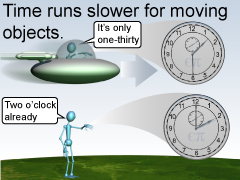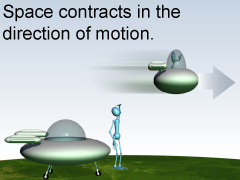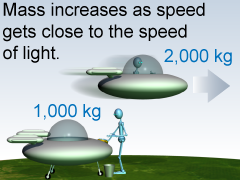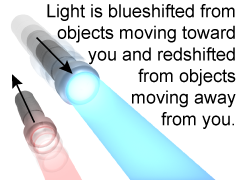|
Special relativity does not affect ordinary experience because the relative velocities need to be at least 100 million m/s before the effects become obvious. Relativistic effects, however, are observed every day in physics labs and in many technologies. 
|
 Time passes more slowly in a moving reference frame when compared to a stationary reference frame. In practical terms, clocks run slower on moving spaceships compared with clocks on the ground. By moving very fast, it is possible to travel into the future. If you were traveling in a spaceship at a speed of 0.9999c (or 99.99% of the speed of light), one year would pass for you while 100 years have passed on the ground. This effect is known as time dilation.
Time passes more slowly in a moving reference frame when compared to a stationary reference frame. In practical terms, clocks run slower on moving spaceships compared with clocks on the ground. By moving very fast, it is possible to travel into the future. If you were traveling in a spaceship at a speed of 0.9999c (or 99.99% of the speed of light), one year would pass for you while 100 years have passed on the ground. This effect is known as time dilation. 
|
 Not just time, but also space itself, varies depending on the reference frame of the observer. The length of an object measured in a stationary reference frame is not the same as the length measured in a moving reference frame. An object does not get smaller or larger: Space itself gets smaller for an observer moving near the speed of light. Space contracts along (or parallel to) the direction of motion.
Not just time, but also space itself, varies depending on the reference frame of the observer. The length of an object measured in a stationary reference frame is not the same as the length measured in a moving reference frame. An object does not get smaller or larger: Space itself gets smaller for an observer moving near the speed of light. Space contracts along (or parallel to) the direction of motion. 
|
 The concept of “simultaneous events” changes when one reference frame is moving relative to the other. Two events that are simultaneous to one observer may not be simultaneous to another who is moving relative to the first observer. The idea of “now” and “then” may no longer refer to the same point in time for observers in different reference frames.
The concept of “simultaneous events” changes when one reference frame is moving relative to the other. Two events that are simultaneous to one observer may not be simultaneous to another who is moving relative to the first observer. The idea of “now” and “then” may no longer refer to the same point in time for observers in different reference frames. 
|
 As the speed of an object approaches the speed of light, its mass increases as measured in any outside reference frame. The closer the speed of an object gets to the speed of light, the more of its kinetic energy becomes mass instead of motion. Matter can never move faster than the speed of light because adding energy creates more mass instead of increasing an object’s speed.
As the speed of an object approaches the speed of light, its mass increases as measured in any outside reference frame. The closer the speed of an object gets to the speed of light, the more of its kinetic energy becomes mass instead of motion. Matter can never move faster than the speed of light because adding energy creates more mass instead of increasing an object’s speed. 
|
 Because light is a wave, it has a frequency, and the frequency is affected by relative motion. Suppose a spaceship moving toward Earth emits red light with a frequency of 462×1012 (462 trillion) waves per second. The same number of waves appear on Earth, but in a shorter time. If the ship were moving at 70% of the speed of light, the waves arrive at Earth at a rate of 630×1012 (630 trillion) waves per second. This is blue light! The frequency of light emitted by a moving object becomes more blue (“blueshifted”) when the object is moving toward you and more red (“redshifted”) if it is moving away from you.
Because light is a wave, it has a frequency, and the frequency is affected by relative motion. Suppose a spaceship moving toward Earth emits red light with a frequency of 462×1012 (462 trillion) waves per second. The same number of waves appear on Earth, but in a shorter time. If the ship were moving at 70% of the speed of light, the waves arrive at Earth at a rate of 630×1012 (630 trillion) waves per second. This is blue light! The frequency of light emitted by a moving object becomes more blue (“blueshifted”) when the object is moving toward you and more red (“redshifted”) if it is moving away from you. 
|

